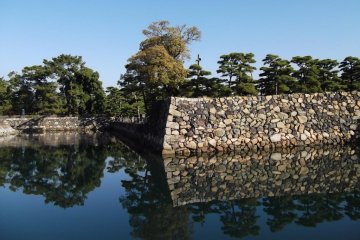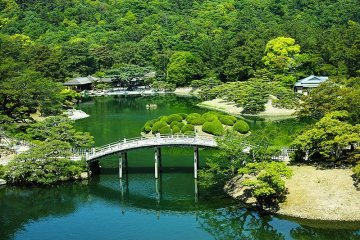
타카마쓰 타마모 공원
Peter Sidell타카마쓰의 페리 항구 옆에 있는 타마모 공원은 푸른 자연만큼 물도 많이 흐르는 쾌적한 공원이다. 해자가 바다와 연결되어 있는 타카마쓰 성의 성터가 남아있고 전통 목조 저택도 있으며 봄이되면 분홍색 꽃들로 장식되는 잎이 무성한 바위 정원의 벚꽃나무들이 있다.

Takamatsu Castle in Kagawa Prefecture is also known as Tamamo Castle. The castle was built in 1590 by Ikoma Chikamasa, the first feudal lord of the Takamatsu Domain. Fifty-four years later the castle and fief were given to the Matsudaira clan. Being built on the shores of Takamatsu, the castle is well known as one of the three mizujiro (water castles) of Japan.
Closed from December 29th to 31st.
Today, the castle grounds—particularly Sakura no Baba—are famous for cherry tree viewing in spring. There are also port facilities to the north side of the castle. Much of the castle is still visible and it has been declared a National Historic Site.
A direct stop at Takamatsu-Chikko Station.

타카마쓰의 페리 항구 옆에 있는 타마모 공원은 푸른 자연만큼 물도 많이 흐르는 쾌적한 공원이다. 해자가 바다와 연결되어 있는 타카마쓰 성의 성터가 남아있고 전통 목조 저택도 있으며 봄이되면 분홍색 꽃들로 장식되는 잎이 무성한 바위 정원의 벚꽃나무들이 있다.

One of the most famous historical gardens in Japan, Ritsurin Garden in Kagawa Prefecture is home to sprawling verdant landscape, a tea house, folk art exhibitions, and even shops. Takamatsu City—where the garden is located—considers it one of the city’s main attractions. The various footpaths and bridges crossing the garden offer a variety of views and vistas all aimed at pleasing the eye and the spirit. To the west, guests can admire the scenery of Mount Shiun overlooking the garden. There are also many koi that can be fed with bread purchased from the Tea House. Covering 750,000 square meters, Ritsurin Garden dates back to the 17th century. The construction of the garden, which began in 1625, took more than 100 years to complete and saw five different masters before reaching completion. In 1953, the garden was designated as a Special Place of Scenic Beauty in Japan.

Shikoku Mura is an open-air architectural park in Takamatsu, Kagawa Prefecture, Japan. It houses over twenty buildings from around Shikoku dating from the Edo period through to the Taishō period, four of which have been designated Important Cultural Properties. Wikipedia
